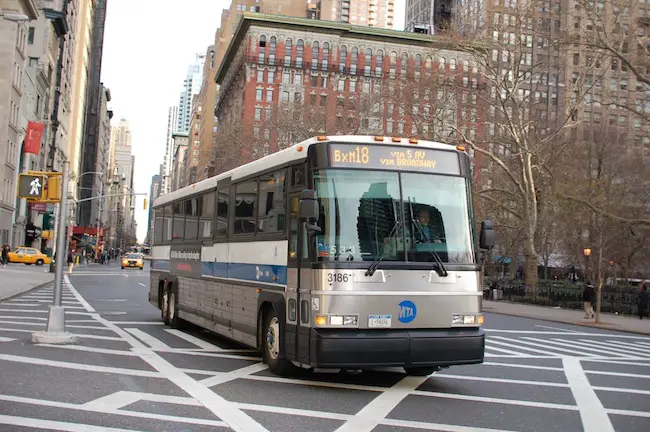The Wheels on the Bus Go Round and Round
Getting around certain parts of New York City can be confusing and frustrating. As any New Yorker will tell you, there’s no ideal solution to getting crosstown at rush hour on a rainy day. It’s a balance of cost, convenience, comfort, and speed. Visitors often opt for taxis, which are convenient and comfortable, but pricey and sometimes slow. Subways are fast and cheap but…well you get the idea.
One mode of transportation visitors don’t use enough is the city bus system. While undeniably a bit slower than the subway, buses are cheap and comfortable (cool in the summer, warm in the winter). Instead of hurtling blindly underground, bus passengers get a street level panorama of the city.

Because most Manhattan subways run north and south, buses are best way to cross the island from east to west. As for convenience, a bus stop is probably within 2 blocks away from wherever you happen to be. And since all buses are accessible, they are ideal for mobility-impaired (or just footsore) visitors.

At first glance, the system may seem confusing, but you just need to know a few bus routes to explore Manhattan. For example, the M20 will take you from Times Square to the World Trade Center passing through Greenwich Village, SoHo, TriBeCa, and Battery Park along the way. The M1, M2 and M3 all run from Harlem to the East Village along Fifth Avenue, traversing the length of Central Park. Just a few of highlights include the Conservatory Garden, Top of the Rock, the Empire State Building, the New York Public Library, and Washington Square Park.
Crosstown buses run every 8 to 10 blocks from Harlem down to Houston St. with several routes traversing Central Park. For example, the M79 will whisk you from the Metropolitan Museum of Art to the American Museum of Natural History with no stops in between. Below the grid, bus routes wind like spaghetti through the Financial District, Chinatown and the Lower East Side.
Bus Basics
Ironically, your bus experience starts in a subway station where you can buy a MetroCard that works both the bus and subway. If you plan to hop on and hop off buses and subways, a 7-day unlimited card (one per person required) is the way to go. A pay-per-ride card can be shared, but transfers are good only for 2 hours on intersecting bus routes. Without an unlimited card, you will have to pay twice for a round trip on the same bus line.
Bus stops are poles topped with a blue and red circle. Signs on the poles indicate the routes that stop there. Ignore the green ones; they are where the express buses gather commuters and whisk them to the outer boroughs. They cost more too. Focus on the blue routes preceded by an M for Manhattan.
Downtown buses mostly stop every two blocks. Some, which flash the word “limited” on the display above the windshield, hopscotch every 10 blocks or so. Crosstown bus stops can be found on every block (because, as walkers quickly realize, crosstown blocks are longer). “Select” buses run in designated lanes on a few downtown avenues and crosstown streets. They allow you to pay your fare in sidewalk machines rather than on the bus.
CityGuide tip: After 10 pm, buses will drop you off between stops. Just ask, and the driver will pull over.
Etiquette
Board the bus using the front door with your MetroCard at the ready. Otherwise, insert your MetroCard upon entering the bus. Insert it with the cut corner to the left and the stripe to the right. As the card pops back out, you will see your monetary balance or expiration date on the display. Cash is accepted but you must have the exact fare (currently $2.75) in coins. No bills, no change. If you pay cash and want to change buses along the way, request a paper transfer in the form of a one-time-use MetroCard.
The first rows of seats are reserved for the elderly or disabled, so move back. You will notice that most single passengers sit next to the aisle. Don’t expect them to slide over to the window to make room for you. For some reason, aisle seats are preferred. It’s considered good form to give up your seat to elders, children and pregnant women.
To request a stop, press the yellow tape or push the red buttons located on the poles. A few buses still have pull cords. Some bus drivers will make announcements about upcoming stops, but you can always ask for a heads up as you approach your destination. Exit the bus through the rear door by pressing on the yellow tapes and pushing. Newer buses have automatic rear doors, which require just a tap to open.
Frustration factor: Bus drivers have schedules to keep. It will be a waste of energy running after a bus that’s pulling out. The door will remain firmly shut.
Resources
Download an official Manhattan bus map from the Metropolitan Transit Authority at http://web.mta.info/nyct/maps/manbus.pdf. The mobile version is called NY Bus and can be used without wifi or the cell network. You will find many free apps for NYC buses promising real time information. Mostly they are not worth the bandwidth. So do as New Yorkers do – wait for the next bus. Eventually it will come.
Chances are, your concierge rides the bus, so don’t hesitate to ask for help planning your jaunts around Manhattan. If you need assistance while out and about, New Yorkers are far from shy. Ask and they will bend over backwards to ensure you get on the right bus in the right direction.
And finally…relax: When your bus is stuck in traffic, and pedestrians are flying by on the sidewalk, be patient. You could be in a taxi with the meter clicking higher and higher or trapped on a subway that suddenly decides to go express. Take a deep breath; sit back in your comfy seat, and text a friend about what a relaxing time you are having in New York City.





